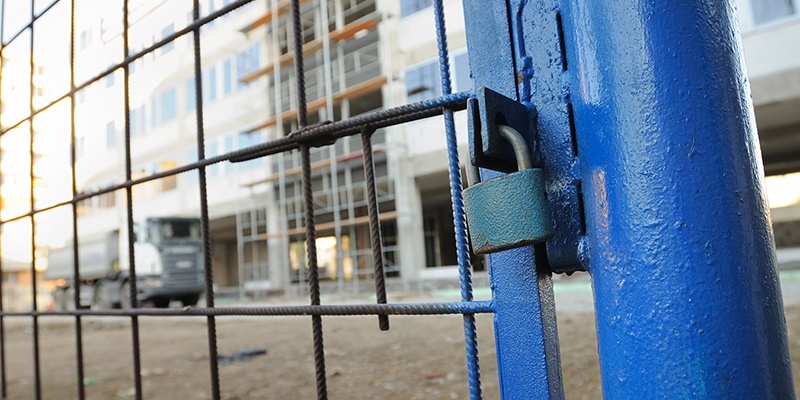Construction Site Security

The labor cost that comes with working on a construction site is expensive, but even more so when you factor in the possibility of theft from employers. In 2021, more than 11,000 thefts occurred at construction sites surpassing convenience store theft (FBI). Many of these stolen items fall under insurance deductibles, so the contractor bears the brunt of the loss.
What Makes Construction Sites Attractive for Theft?
Construction sites are attractive due to the many high-value items that can be easily stolen, as they are often untraceable. Many times, large sites contain hundreds of thousands of dollars of equipment and material, often reaching into the millions at large sites. If not secured, these items can be stolen quickly and easily without notice. If given enough time, thieves can steal other high-value equipment by using trailers to haul them away from the construction site.
Understanding Construction Site Theft: Common Types and Reasons Behind It
- Copper wire and scrap metal
- Tools
- Generators
- Doors and windows
- Plumbing supplies and fixtures
- Loaders
- Backhoes
- Bobcats
- Older and existing equipment lack the 17-digit vehicle registration numbers.
- Many sites are open.
- Subcontractors and deliveries constantly flow in and out of sites.
Strengthening Your Construction Site Security: Strategies for Protecting Your Assets
Due to the recent increase in theft and crime at construction sites, organizations should consider consistently improving their security standards. The financial costs of improvements can potentially reduce your loss and improve your business’ reputation. Businesses and organizations that show strong safety practices could experience lower losses as well as happier and safer employees.
The below checklist list could help your organization to improve security practices:
- Establish a written job site security plan and assign supervisory security responsibilities.
- Encourage security awareness among all workers and require prompt reporting of incidents of theft and vandalism.
- Maintain an inventory control system for all equipment and tools. Keep careful ownership records by finding numbers on each machine, writing them down and identifying where the numbers are located. Take pictures of large ticket items. Keep this information readily accessible.
- Mark your equipment with an identification system, such as a driver’s license number (state initials, number, followed by DL). This is the only traceable number in all 50 states. Put numbers in two spots: one that’s obvious and one that’s hidden. Weld company name on equipment.
- Disable heavy equipment before leaving the job site. Obtain universal keys. Removing a battery or steering wheel may discourage a thief. Be sure to disable equipment with hidden switches.
- Install anti-theft devices on equipment, such as fuel cutoffs, hydraulic bypasses, track locks or alarms.
- Install GPS on larger pieces of equipment.
- Lock oil and gas tank caps where possible to deter vandalism.
- Park equipment in well-lit secure areas.
- Keep equipment and supplies locked in securable storage sheds.
- Remove expensive items from a job site.
- Provide nighttime lighting for the site.
- Install fences that limit all accessible entry points. The National Equipment Registry recommends adding a fence around the site and augmenting with motion sensor lighting and an alarm system. Walk the perimeter on a regular basis to look for breaches where someone could enter the site. If a breach exists, repair it immediately. If possible, limit the project site to one controlled access point.
- Provide parking areas outside of the site for employees and visitors.
- Post trespass warning signs. This could elevate the theft from a misdemeanor to a construction site felony crime. Other signs to post include: "Private Property," "Vehicles May Be Searched," the contractor's and builder's contact information and reward program signs.
- Use surveillance cameras. The idea of being caught on video may deter some criminals.
- Change padlocks on gates and around the site several times during construction.
- Twenty-four hour onsite personnel. In high-crime areas or large projects with substantial materials onsite, overnight staff should be located on site to secure the project area. Often, employees alone can deter criminals from entering the site.
Installing Security and Camera Systems
As technology has improved, the cost of cameras and security systems has significantly decreased. Many of these systems can be installed by contractors without the need for professional installation. These systems can detect motion after hours, provide night vision capabilities and remote monitoring via a smartphone. Certain systems allow for monitoring that includes unique ID badges for employees and remote locking systems. New out-of-the-box systems that can be installed easily and include cameras, flood lights and motion sensors as well.
Reporting Crime
All crimes, including trespassing, should be reported and recorded by your organization. Reports should include:
- Location and Date of Incident
- Approximate Time of the Incident
- Individuals Involved
- If possible, include names, job titles and address information.
- Description of Incident
- Who was the Incident Reported to?
- Local Authorities: All crimes related to theft and vandalism should be reported immediately. If your organization does not know whether or not to report an incident, it is best to contact authorities. They can provide you with additional information and advice on your local area.
- Report to Insurance Carrier
- Items Stolen or Destroyed
- Witness Information (If Applicable)
- Witness Name
- Address and Contact Information
- Name of Person Completing Form
- Attaching photos and video footage to the report
Recording all incidents allows your organization to track patterns in losses as well as any substantial increases in theft. All organizations should evaluate their losses and look to improve their security standards based on the information.